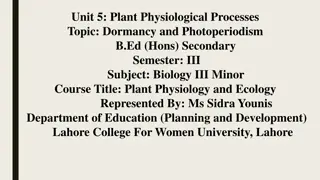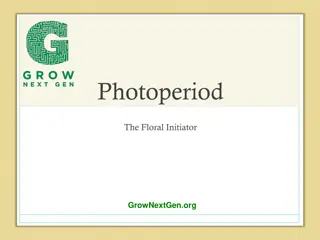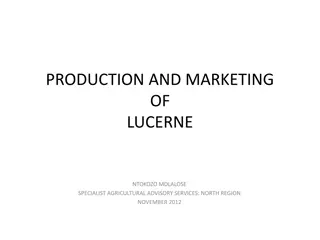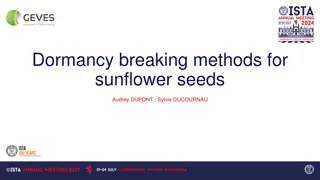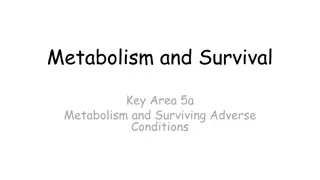Understanding Plant Hormones and Their Functions in Plants
Plant hormones play crucial roles in various plant processes such as growth, development, and response to environmental stimuli. Auxins, gibberellins, and abscisic acid are key plant hormones that regulate tropisms, cell division, elongation, flowering, seed germination, and dormancy. Understanding
1 views • 50 slides
Understanding Seed Dormancy and Ways to Break it
Seed dormancy is a crucial aspect of plant growth, where seeds remain inactive and do not germinate even under favorable conditions. Various reasons contribute to seed dormancy, such as light, temperature, and hard seed coats. Different types of dormancy like innate, enforced, and induced are explai
1 views • 9 slides
Understanding Seed Anatomy and Germination Processes
Explore the anatomy of seeds, including taxonomic classes like angiosperms and gymnosperms, subclasses within angiosperms, and components of a seed such as the embryo, endosperm, and seed coat. Learn about seed germination conditions, dormancy, and factors like favorable temperature and scarificatio
0 views • 17 slides
Investigating Yeast Activation: What Does Yeast Need to Break Dormancy?
This investigation delves into understanding what yeast requires to become active and break its dormancy. By providing warmth, water, and food sources like cookies, students study the impact of these elements on yeast activation. Through practical experiments involving yeast in different conditions,
7 views • 11 slides
Understanding Dormancy in Plants: Causes and Implications
Dormancy in plants, involving seeds and buds, is a state where growth is temporarily halted due to internal or external factors. Factors like immature embryos, impermeable seed coats, and growth inhibitors contribute to seed dormancy. The presence of inhibitors like abscisic acid and the influence o
0 views • 43 slides
Understanding Photoperiodism in Plants
Photoperiodism is the ability of plants to detect day length, allowing them to know the season of the year and trigger specific physiological events. Earth's axis tilt and latitude influence day length variations, leading to distinct photoperiod responses in plants. This phenomenon plays a crucial r
0 views • 13 slides
Lucerne Production and Marketing for Agricultural Advisory Services
Lucerne, a perennial crop grown widely as forage for cattle, requires well-drained soil and specific climatic conditions for optimal production. It is drought-tolerant but responsive to irrigation. Choosing the right seed variety based on winter dormancy is crucial for successful lucerne cultivation
0 views • 34 slides
Efficient Methods for Breaking Dormancy in Sunflower Seeds: A Study Update
Seed dormancy in sunflowers post-harvest presents challenges, with conventional methods like pre-chilling and pre-heating often inadequate. A recent study in France explored the use of Ethrel treatment as a more effective approach to overcome seed dormancy in sunflower seeds. Preliminary results sug
0 views • 6 slides
Adaptations to Survive Adverse Conditions in Organisms
Organisms develop various adaptations to survive adverse conditions like extreme heat, cold, drought, or lack of food. Through dormancy, hibernation, aestivation, and daily torpor, they regulate their metabolic activities to conserve energy and ensure survival in challenging environments.
0 views • 16 slides
Understanding Plant Hormones and Their Role in Pharmacognosy
Plant hormones, also known as phytohormones, are essential chemical compounds in plants that regulate various developmental processes. They include auxins, gibberellins, cytokinins, ethylene, and abscisic acid, each with specific functions in growth, reproduction, and response to environmental stimu
0 views • 21 slides
Discussion on SCell Dormancy and Switching in RAN4#95e Meeting
At the recent RAN4#95e meeting, various topics related to SCell dormancy and switching were discussed, including delays in transitioning between dormancy and non-dormancy states, interruptions during switching, and CSI/RRM measurements during dormancy. Agreement was reached on switching conditions b
0 views • 14 slides

